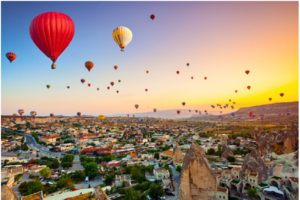When Is the Best Time to Trek to Everest Base Camp with Sherpa Expedition & Trekking?

The perfect time to do the trek to Everest Base Camp with Sherpa Expedition & Trekking is during the two popular trekking seasons in Nepal: the spring season (March to May) and autumn season (September to November). These are the best seasons to trek as the weather remains clear and trekking becomes a smooth ride.
Trek to Mount Everest Base Camp March to May, spring is a wonderful time to do the Everest Base Camp trek. Environment We have nice weather, with a clear sky and mild temperature that makes you feel more comfortable when trekking. The flora in the area, especially the rhododendron forests, is in full bloom during these months, which is a wonderful sight for the eyes. The Himalayas are usually visible in pristine clarity, taking trekkers’ perfect pictures. What’s more, the pre-monsoon spring is less likely to bring rain, snow, and the trails are relatively dry and more defined, meaning less chance of slipping and difficult walking.
Another peak season for the Everest Base Camp trek is the autumn season, which falls between September and November. The weather is also in spring, very stable, cool, and clear. This season is especially nice after the rainy season, when the air is fresh and the peaks all around you glisten in the clear skies. Conditions are perfect for trekking , and the views of Mount Everest and other surrounding peaks are amazing. Autumn also usually offers a lull in the constant flow of trekkers than the more popular springtime period, thus creating a more tranquil trekking experience, while also ensuring you can have time to take in the magnificent views.
Although these two seasons are the ideal periods for trekking to Everest Base Camp, personal preferences also need to be taken into account. Winter (December – February) and summer monsoon months (June – August) are usually not considered as it is extremely cold | snowy, or high chance of rain, which could make the trail slippery or make vision hide to find the path. No matter the season, when you trek with Sherpa Expedition & Trekking, you will be suitably equipped and supported to guarantee you have a safe and satisfying adventure to the Everest base camp.
Introduction: The Time and Place of EBC
When to do the Everest Base Camp Trek is everything. When to go: The time of year you visit can greatly impact the success of your adventure and the experience, overall. The journey passes through some of the world’s most rugged territory with weather that can be fickle and can change drastically over the seasons.
Picking the right timing means you have the highest probability of clear skies, moderate temperatures, and minimal inconvenience to your trek. Furthermore, if you are trekking in the peak seasons, you will have more teahouses to choose from, more experienced guides, a more lively trekking region, and you will be less at risk to severe weather conditions.
Scientifically, there are two trekking seasons for EBC – spring and autumn. (Certainly, each has its selling points, but it’s equally important to consider weather, crowd size, and personal interests before making a decision). Whether you are looking for stunning vistas, less trail congestion, or more comfortable temperatures, there are a whole slew of factors that impact the experience, among the most important of which is when you go.
Nevertheless, despite being a year-round trek, knowledge about the characteristics of weather and trekking during various seasons will help you make your adventure as comfortable and as rewarding as it can be.
Pros and cons of Spring and Autumn trekking peak seasons
Most Everest Base Camp treks will be planned out during the two peak seasons – spring (March to May) and autumn (September to November). All of these seasons have pros and cons, and deciding between them is all a matter of where you fall on the spectrum of likes and dislikes.
Spring, which is from March to May, is the first of the peak seasons and is one of the best times of year to go trekking. Although during these times the trail gets relatively much less crowded compared to autumn, the hike isn’t free from people.� The days are longer, and the weather tends to be relatively stable, offering good trekking conditions. Spring will also bring a blanket of wildflowers lining the trail and accenting the beautiful view. If you’re interested in seeing a plethora of flowers in the Everest region, then spring is the perfect time.
Everest Base Camp Treks. Meanwhile, in autumn, many believe it’s the best season for EBC trekking. AFTER THE MONSOON Once the monsoon season ends, the sky clears, presenting trekkers with the most stunning views of the surrounding peaks that you could imagine. The weather is usually steady, with dry conditions and moderate temperatures, but the crowds may be bigger, as this is the most popular time of year for trekking in Nepal. Fall has clear weather and a cool atmosphere, so visibility is good. And picture-taking is recommended in the fall.
Each season has its pros and cons: spring, the no-show of the tourist, autumn weather, and visibility godsends. In the end, it’s all about preference.
Pros of Trekking during Spring
There are many advantages of trekking to Everest Base Camp in spring, for those who would want their trip to be perfect in such a way! Spring is from March to May, with moderate temperatures and fair weather. This makes it one of the best periods to trek the Khumbu as the paths are clearer and the view is stunning. The daytime temperature tends to be in the range of 10- 15 °C (50-59F) at lower altitudes, and the nighttime temperature may drop to about -10 °C (14°F) at higher altitudes.
One of the best advantages of the spring treks is that there are considerably fewer people as compared to the autumn treks. It is still a high season for EBC travels, but spring months usually are not as packed, which can give you a bit more of a peaceful, personal journey on the trail. This is perfect for trekkers who like a less touristic and more intimate trek, as the teahouses and trails aren’t as busy and the overall ambience is far more laid back.
In spring, you can also enjoy the beauty of the region’s exquisite flora. Wildflowers come into bloom, adding splashes of color to otherwise rugged mountain scenes, and the higher temperatures mean trekking can be more comfortable. The weather is mostly dry and clear, which offers trekkers the best visibility of Everest and surrounding peaks, and a spring trek turns out to be an unforgettable experience.
Autumn is Perfect for EBC Too
Mount Everest Base Camp Trek Most people say that (Sept–Nov) Autumn is the best time for the Everest Base Camp trek due to perfect weather and clear views. The skies clear after the monsoon, and trekkers get great views of Mount Everest and its nearby peaks. The foliage is clear, pure, and dry, which are ideal conditions for hiking over the rough Himalayan paths.
Wander with Me. One of the greatest things about trekking in the autumn is that you can expect relatively stable weather. Unlike in the spring, autumn is generally drier, and the odds of precipitation in the form of rain or snow are relatively low, which can make trekking at higher altitudes far more doable. Temperatures are moderate, and between 10 and 15°C (50 and 59°F) during the day on the lower levels, although at night it becomes cold. But most of the time, the weather is still juicy, with just enough sunny days for some great trekking.
It’s also the time with the most trekkers, an advantage and a disadvantage. On the one hand, teahouses and infrastructures are in situations that are ready to use and work. On the other hand, the trails could be busier, especially around popular stops like Namche Bazaar and Tengboche. Regardless of crowds, with the clear weather and incredible views of Everest and other summits, autumn is by far one of the most popular times of the year for those wishing to trek at the best trekking time.
The weather on the EBC Trek
The weather on the Everest Base Camp trek is one of the key considerations when organising your trip. The weather changes in the landscape with altitude, season, and time of day, which can have direct effects on the ease and security of the trek. These climate patterns are crucial in preparing to get the most out of your trek and for keeping comfortable as you traverse them.
The weather is cold and dry, especially at higher elevations after the monsoon, where the daytime temperature is anywhere from 10°cC (50°F) to -10°C (14°F) at the base camp. The trail has its own set of conditions: low-altitude spots such as Lukla and Namche Bazaar are relatively warm and temperate, with daytime temperatures of about 15 °C (59°F), cooling to sub-freezing at night.
Months of spring and autumn have the most even weather and the lowest chance of rain and clear skies. But conditions can shift quickly, particularly at high altitudes. It can be colder by the time trekkers reach Gorakshep and Everest Base Camp, even dropping temperatures well below freezing after dark. Snow and ice could also be expected, particularly in the winter.
Wind can be strong, especially at higher elevations, so it is important to prepare for cold weather. Being aware of what the weather will be like for each stage of your trek allows you to pack accordingly and prepare and alter plans if needed, so that you have a safe and enjoyable time.
Off-season Trekking: What to Look out for
Everest Base Camp An off-season EBC trek, usually held in winter (December – February) or during monsoon (June – August), is a different adventure from peak trekking times. It’s not for everyone, but shoulder season trekking presents its unique opportunities and challenges. One of the many benefits is the lack of crowds. This means that trekkers are free to enjoy a quieter, small-group experience along the trail. Accommodation is also easier to find with fewer crowded teahouses. But this peace is not without its struggles. The winter months can see temperatures drop well below freezing, and snow can be on the trails, making them tougher. During monsoon time, there is a lot of rain and landslides may be possible, and the road gets too slippery. The weather may also hinder your view, and the scenic views would be hard to see. Notwithstanding these difficulties, off-season trekking provides a unique experience, a chance to interact and bond with the Sherpa people in a much quieter and peaceful environment. For Sirdar Sherpa Expedition & Trekking, they are well-trained and well-prepared, with expert advice, such as how to be careful and responsible trekkers, while embarking on a secure journey that is fun-filled during and outside of the trekking hours.
Influence of weather on the experience of trekking
Your trekking experience on the Trek to Mount Everest Base Camp trail depends a lot on the weather. The best time to trek to EBC is Spring (March to May) and Autumn (September to November) when the weather is moderate and it doesn’t rain much, which adds to the comfort and joys of a journey. But climates can vary significantly outside these months. During the winter months (December – February), temperatures can dip, and at some higher altitudes, it can be difficult to trek comfortably. There may be snow, and the trail may be snowed in, slippery, and dangerous across snow fields. On the other hand, the summer monsoon season (June to August) may bring heavy rain, leading to some muddy trails and the chance for landslides or avalanches. The views of the Himalayas are majestic, but they are often spoiled by the poor visibility during the monsoon storms. Good timing in trekking means a greater possibility of safety, comfortable conditions, and no hassles on the trail; however, whether it’s done in the Summer season or otherwise, you’ve got a guarantee that Sherpa Expedition & Trekking offers a well-arranged and maintained trekking trip even in poor weather conditions. Their experience and familiarity with the area help trekkers to acclimate better and get the most out of the trip.
The one that you prefer would be the best time to participate.
When to do the Himalayan Base Camp Trek? The best time to do the Everest Base Camp trek depends on your preferences and the type of experience you are looking for. If you want a pleasant hike in clear weather, moderate temperatures, and great views of the Himalayas, visit in either spring (March to May) or autumn (September to November). These months offer the perfect combination of good weather and beautiful mountain scenery, so they are the busiest periods for trekking. But if you’re into your solitude — and are unfussed by tougher conditions — hiking out of season can be a glorious option. Winter (December through February) is equally tranquil with fewer tourists, but brace yourself for colder temperatures and, in the case of the latter half of winter, snow. Alternatively, trekking during the height of monsoon season (June to August) brings its own set of challenges, including rain and possibly treacherous trail conditions, but it’s also when the densely covered terrain is vivid and green. This can be guaranteed with Sherpa Expedition & Trekking in any season of the year with expert advice and assistance. In the end, when it’s the best time to trek to Everest Base Camp depends on what you value most: best weather, the least amount of crowds, or a tougher experience.
How Sherpa Expedition & Trekking Adds Value to Your Adventure: What you can expect and hope to experience while trekking with us.
Sherpa Expedition & Trekking is an epic option, and it has a proven record of great service, great guides, and great local knowledge for your Everest Base Camp experience. Whether you decide to go by foot in the spring, summer, or fall, their crew of long-time Sherpa guides and porters will train you to trek like a champ. When the trails are crowded with trekkers, the peak season Sherpa Expedition & Trekking will work on guaranteeing that your accommodation, permit, and transportation will be organized very well, so you can make your trip as you want. For off-season trekkers, the expertise of the Sherpa team is all the more essential. They also serve as a guide through the tougher weather of snow and heavy rain, assuring you of safety and convenience. Their extensive knowledge of local customs and traditions gives an extra dimension to the trip, introducing you to the local Sherpa culture and their way of life. With a dedication to excellent service, including excellent gear, healthy food, and support every step of the way, Sherpa Expedition & Trekking stands out among the rest. With their team of professionals, you can enjoy your EBC trek whenever you decide to make it.
Final Thoughts: Prepping for The Ultimate EBC Trek
Planning the way to a perfect Everest Base Camp Trek Cost, is the time to go and a good trekking company (and we just happen to know the best one for your EBC Trek) to guide you through this classic trek. And whether you’re taking on the popular spring season or the post-monsoon autumn season, or the monsoon off-season experience, the right preparation and support is the key. Think about how in shape you are, how much solitude you want, and how well you tolerate a variety of weather. Planning also includes choosing gear, getting permits, and knowing the risks of high-altitude trekking. Sherpa Expedition & Trekking will make your journey easy and help you to explore the hidden treasures of Nepal while learning about the culture and traditions of Nepalese society from experienced Sherpa guides who explain every in and out of the trek. Their itineraries are very organized, and you can take it easy with plenty of rest days to accustom yourself. With their guidance, you can concentrate on the stunning landscape, the trekking challenge, and the profound interaction with the Sherpa culture. In the end, the ultimate EBC trek experience is the one that suits your needs and won’t leave you feeling unsafe or underprepared to bask in a once-in-a-lifetime opportunity at the base of the world’s tallest mountain.







